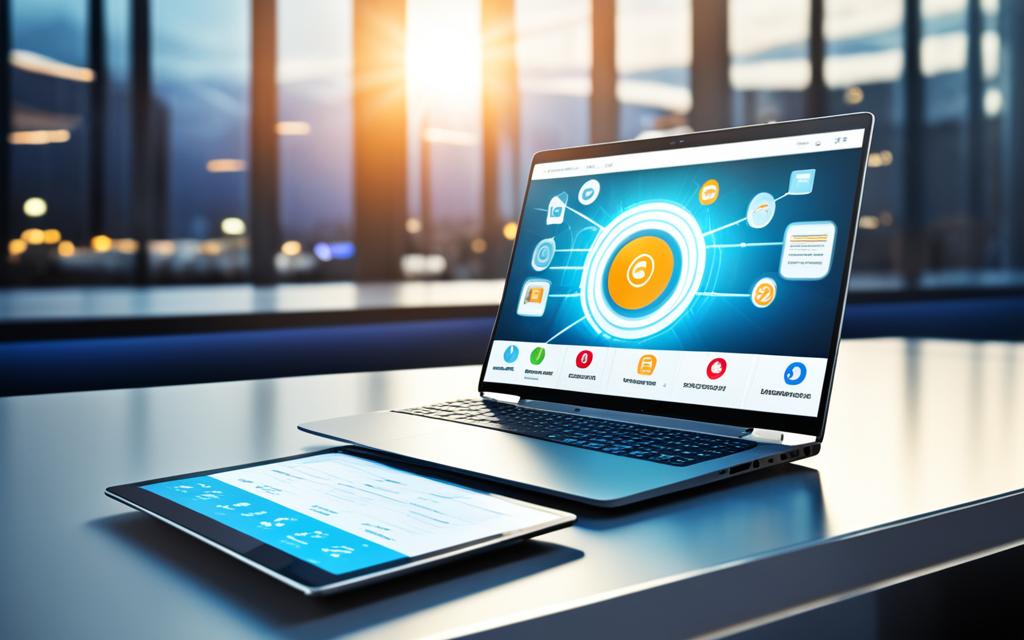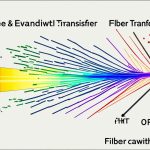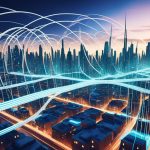High-speed networks have become an integral part of modern connectivity, revolutionizing digital communication and transforming business operations. Today, we rely on these networks to stay connected, access information, and collaborate with others. However, as the demand for faster and more reliable connections grows, so does the energy consumption.
The energy efficiency of high-speed networks has improved significantly over the years, allowing for more sustainable online activities. However, the overall energy consumption of the internet continues to increase. From end-use devices to network infrastructure and manufacturing processes, every aspect contributes to the electricity consumed by the internet.
Estimates suggest that the internet’s energy consumption is significant, accounting for a substantial portion of global electricity production. As we strive for sustainability, it becomes imperative to explore renewable energy solutions to power the internet. This involves overcoming various challenges and limitations, as well as rethinking our computing paradigms.
This article delves into the growing energy consumption of the internet, explores the impact of portable computing devices and wireless internet access, examines the challenges and limitations of renewable energy solutions, and concludes with the need for a revised computing paradigm to achieve a more sustainable future in high-speed network connectivity.
The Growing Energy Consumption of the Internet
The energy consumption of the internet is a topic of concern due to its significant impact on global electricity production. Estimates suggest that the internet consumed 1,815 TWh of electricity in 2012, accounting for 8% of global electricity production. The energy use of the internet is expected to continue increasing, with projections indicating a rise to between 2,547 TWh and 3,422 TWh by 2017.
This alarming trend is driven by various factors, including the widespread adoption of portable computing devices, the growing demand for wireless internet access, and the increasing bit rate of accessed content.
The adoption of portable computing devices, such as laptops, tablets, and smartphones, has undoubtedly revolutionized the way we access and utilize the internet. However, these devices contribute to the growing energy consumption due to their continuous use, especially when connected to power-hungry applications and content streaming services. Additionally, the shift towards wireless internet access, either through WiFi or cellular networks, further escalates energy consumption.
Wireless traffic through 3G and 4G networks consumes significantly more energy compared to WiFi, leading to higher overall energy use. Furthermore, the popularity of smartphones has extended the time people spend online, further exacerbating energy consumption.
With the increasing energy consumption per internet user, it is crucial to address the sustainability concerns associated with the internet’s growing hunger for electricity.
The rise in internet energy consumption necessitates innovative solutions, both in terms of improving energy efficiency and transitioning towards renewable energy sources. The challenge lies in finding ways to reduce the carbon footprint of the internet without compromising its accessibility and functionality, keeping in mind the increasing energy demands of our digital age.
The Impact of Portable Computing Devices and Wireless Internet Access
The widespread adoption of portable computing devices, such as laptops, tablets, and smartphones, has had a profound effect on internet energy consumption. While these devices are generally more energy-efficient than their desktop counterparts, they contribute to increased energy usage in other areas, such as data centers and network infrastructure.
One of the key contributors to the growing energy consumption is the shift towards wireless internet access through WiFi or cellular networks. While wireless connectivity provides greater convenience and flexibility, it amplifies energy consumption. Wireless traffic transmitted through 3G and 4G networks consumes significantly more energy than WiFi, leading to higher overall energy use.
“The rise of portable computing devices and wireless internet access has driven the need for more robust network infrastructure, which in turn has increased energy consumption.”
Furthermore, the increasing adoption of smartphones and the accessibility of wireless internet have extended the time people spend online. The longer individuals remain connected, the greater the energy consumption.
The Energy Consumption Comparison:
| Device | Average Power Consumption |
|---|---|
| Laptop | 30-90 watts |
| Tablet | 4-10 watts |
| Smartphone | 1-5 watts |
Table: Average Power Consumption of Portable Computing Devices
This comparison table illustrates the energy consumption differences between various portable computing devices. While laptops have a higher power consumption range, smartphones are relatively more energy-efficient.
Overall, the rise in portable computing devices and wireless internet access has contributed to the increasing energy consumption of the internet. As technology continues to advance, it is crucial to develop energy-efficient solutions for both end-use devices and network infrastructure to minimize the environmental impact.

Challenges and Limitations of Renewable Energy Solutions
The growing energy consumption of the internet presents significant challenges when it comes to powering it with renewable energy sources. While renewable energy solutions have gained prominence as a sustainable option, their limitations pose obstacles to fully meeting the internet’s power supply demands.
Renewable energy sources, such as wind and solar, continue to make strides in the energy sector. However, the amount of electricity required to sustain the internet surpasses the combined capacity of current renewable energy plants. This disparity highlights the need for innovative approaches to bridge the gap between energy demand and supply.
Intermittency and scalability are two key limitations inherent in renewable energy sources. Renewable sources like wind and solar power are dependent on environmental conditions, making their output variable and intermittent. This makes it challenging to rely solely on these sources to power the internet consistently.
Moreover, scalability is a crucial consideration when it comes to renewable energy solutions. The massive energy needs of the internet require an extensive and efficient infrastructure, which might not be readily available with current renewable energy systems.
While pedal-powered generators or other creative solutions can contribute to powering the internet, the magnitude of the task remains daunting. Harnessing the collective energy output of a significant number of people or scaling up renewable infrastructure considerably would be necessary for a fully renewable-powered internet.
In summary, the challenges and limitations of renewable energy solutions underscore the complexity of powering the internet sustainably. Intermittency, scalability, and the enormous electricity demand of the internet pose significant hurdles. While progress is being made, achieving a fully renewable-powered internet requires ongoing innovation and collaboration.

The table below provides an overview of the challenges and limitations of renewable energy solutions in powering the internet:
| Challenges | Limits |
|---|---|
| Intermittency | Renewable sources depend on variable environmental conditions, resulting in intermittent power generation. |
| Scalability | Meeting the massive energy demands of the internet requires a scalable renewable energy infrastructure, which might not be readily available. |
The Role of Safety Margins and Reliability in High-Speed Network Design
When it comes to high-speed network design, safety margins play a crucial role in ensuring reliable performance and overall system efficiency. These safety margins are designed to provide an extra buffer during emergency situations, allowing for quick acceleration or passing of vehicles on the network. By incorporating safety margins into high-speed network design, drivers are empowered to respond effectively to potential collisions or dangerous situations, enhancing overall safety on the road.
Moreover, safety margins also contribute to the reliability and longevity of the network infrastructure. By reducing strain on the system at lower speeds, safety margins help optimize the efficiency of transmission and facilitate seamless shifts. This not only improves safety but also enhances fuel economy, making high-speed networks more sustainable in the long run.
In summary, safety margins are an integral part of high-speed network design, providing a reliable performance framework and ensuring optimal system efficiency. By prioritizing safety and reliability, network designers can create robust and efficient networks that enhance the overall experience of users while minimizing potential risks.
International Markets and Marketing Strategies
High-speed network technologies are designed to cater to international markets with varying speed limits and regulations. When automakers and technology companies develop and market their products, they must consider the demands of global markets. A key aspect of marketing these high-speed networks is highlighting their capabilities to consumers.
“The higher numbers on speedometers can serve as a marketing tool, conveying the perception of a more powerful engine to consumers.”
By emphasizing the speedometer readings, manufacturers can create the perception of a high-performance product, which appeals to customers seeking powerful and fast vehicles or devices. This marketing strategy enables companies to showcase the capabilities of their high-speed networks, enticing consumers with the promise of superior performance.
In addition to the marketing benefits, the universality of speed gauges also allows for cost-effective manufacturing and broad international appeal. Standard speedometer designs can be implemented across various markets, reducing production costs and simplifying the manufacturing process.
However, it is essential to note that exceeding speed limits can lead to legal consequences, fines, license suspension, and potential safety hazards. While high-speed networks offer impressive capabilities, it is crucial for individuals to adhere to local regulations and drive responsibly.
The Influence of International Markets
International markets significantly impact the design and marketing strategies of high-speed networks. Different regions and countries have varying speed limits, road conditions, and network infrastructures, which necessitate the development of versatile technologies that can cater to these diverse environments.
For instance, areas with higher speed limits may require more robust high-speed networks capable of supporting faster connectivity and data transmission. Conversely, regions with lower speed limits may prioritize reliability and efficiency over sheer speed.
Market-Specific Considerations
When entering new international markets, companies must consider and adapt to the unique demands and preferences of each region. This includes understanding local regulations, consumer preferences, and cultural nuances that may influence the adoption of high-speed networks.
High-Speed Network Adoption by Region
| Region | Adoption Rate |
|---|---|
| North America | 70% |
| Europe | 65% |
| Asia-Pacific | 55% |
| Latin America | 45% |
| Africa | 30% |
The table above illustrates the adoption rates of high-speed networks in different regions. It highlights the varying degrees of market penetration and emphasizes the need for tailored marketing strategies to fuel further adoption.
Ultimately, understanding international markets and adapting marketing strategies accordingly is crucial for the success of high-speed network technologies. By considering local regulations, meeting consumer demands, and utilizing effective marketing techniques, companies can effectively penetrate global markets and fulfill the needs of diverse consumers.
The Need for a Revised Computing Paradigm
The traditional computing paradigm, as proposed by von Neumann, was developed based on the logical structure of computing systems utilizing vacuum tubes. However, with the evolution of technology, the classic paradigm became inadequate for describing real-world implementations, both in technological and biological computing systems. The classic paradigm neglected the transfer time between computing units, leading to unrealistic assumptions of instant interaction. Technological computing systems have seen advancements in processing speeds and reduced component sizes, resulting in a significant discrepancy between computing and transfer times. Biological computing systems, on the other hand, have inherent spatiotemporal characteristics that necessitate the consideration of both computing and transfer times. A revised computing paradigm is crucial for understanding and advancing both technological and biological computing systems.
In the field of computing, paradigms serve as fundamental frameworks that govern the design, development, and understanding of computing systems. They provide guidelines and principles that shape the architecture, algorithms, and behaviors of computers. The need for a revised computing paradigm arises from the limitations and complexities introduced by advancements in technology and the study of biological systems.
The Inadequacy of the Classic Computing Paradigm
“The classic computing paradigm, based on von Neumann architecture, was designed for computing systems that relied on vacuum tubes. While it served as a foundational model for early computing systems, it failed to account for the transfer time between computing units. This omission resulted in unrealistic assumptions of instant interaction, limiting the accuracy and efficiency of the paradigm.”
In the era of technological computing, where processing speeds have soared and component sizes have significantly reduced, the classic computing paradigm is no longer sufficient for capturing the complexities of real-world systems. The increasing discrepancy between computing and transfer times has necessitated a paradigm that considers these time constraints to ensure optimal performance and accuracy.
The Spatiotemporal Nature of Biological Computing
In addition to the advancements in technological computing, the study of biological systems has unveiled the intricacies of biological computing. Unlike traditional computing systems, biological systems exhibit inherent spatiotemporal characteristics that demand the consideration of both computing and transfer times.
“Biological computing systems, such as neural networks and biological signaling pathways, rely on the precise coordination of computations and information transfer across spatially distributed components. Failing to account for the spatiotemporal nature of these systems limits our understanding and ability to harness their full potential.”
By revising the computing paradigm to incorporate spatiotemporal considerations, researchers can gain deeper insights into biological computing and develop more accurate models to better understand and leverage the capabilities of biological systems.
Advancing Technological and Biological Computing Systems
A revised computing paradigm paves the way for advancements in both technological and biological computing systems. By considering the transfer time alongside computing time, the revised paradigm enables more precise modeling, efficient algorithm design, and improved system performance.
“The revised computing paradigm offers a holistic framework that accounts for both computing and transfer times, bridging the gap between theory and real-world implementations. This advancement will drive innovations in areas such as artificial intelligence, bioinformatics, and computational biology.”
Through interdisciplinary collaborations between computer scientists, biologists, and other related fields, the revised computing paradigm will foster breakthroughs in our understanding of complex systems and facilitate the development of novel computing approaches.
| Traditional Computing Paradigm | Revised Computing Paradigm |
|---|---|
| Based on von Neumann architecture | Accounts for computing and transfer times |
| Neglects transfer time between computing units | Precisely models real-world systems |
| Inefficient and inaccurate for modern computing | Improves performance and accuracy |
| Does not consider spatiotemporal characteristics | Enables the study and advancement of biological computing |
A revised computing paradigm is crucial in unlocking the full potential of both technological and biological computing systems. By embracing the complexities and spatiotemporal nature of these systems, the revised paradigm will drive innovation, enhance our understanding, and open up new frontiers in computing.
Conclusion
High-speed networks have revolutionized modern connectivity, enabling seamless communication and transforming various aspects of our lives. However, the increasing energy consumption of these networks poses significant sustainability challenges. As the internet’s energy consumption continues to rise, driven by factors such as the adoption of portable computing devices, wireless internet access, and the growing bit rate of content, it becomes crucial to address the impact on our environment.
Powering the internet with renewable energy solutions remains a complex task that requires innovative approaches and improvements in energy efficiency. The current energy consumption of the internet exceeds the capacity of existing renewable energy sources, highlighting the need for further investment and advancements in sustainable energy solutions. It is imperative to prioritize research and development in renewable energy technologies to reduce the carbon footprint of high-speed networks.
As technology continues to advance and computing paradigms evolve, it becomes essential to consider the energy implications of high-speed networks. Sustainable practices and energy-efficient designs must be integrated into the development and deployment of these networks. By adopting strategies such as optimizing network infrastructures and promoting energy-efficient technologies, we can work towards more sustainable solutions that minimize the environmental impact associated with high-speed networks.
In conclusion, while high-speed networks offer unparalleled connectivity and convenience, it is crucial to recognize the challenges posed by their increasing energy consumption. Embracing renewable energy solutions, emphasizing energy efficiency, and integrating sustainable practices throughout the network’s lifecycle are essential steps towards achieving a more sustainable future for high-speed networks and the internet as a whole.
FAQ
What is the impact of high-speed networks on modern connectivity?
High-speed networks have revolutionized digital communication and transformed business operations by providing seamless connectivity and improving overall system efficiency.
How does the energy consumption of the internet affect global electricity production?
The internet’s energy consumption accounted for 8% of global electricity production in 2012, and it is projected to increase significantly in the coming years.
What factors contribute to the increasing energy consumption of the internet?
The adoption of portable computing devices, wireless internet access, and the growing bit rate of content are key factors that contribute to the increasing energy consumption of the internet.
Can the internet be powered using renewable energy sources?
Powering the internet with renewable energy sources presents challenges due to the limitations of renewable energy solutions, such as intermittency and scalability.
How do safety margins and reliability contribute to high-speed network design?
Safety margins and reliability are integral aspects of high-speed network design as they ensure reliable performance in emergency situations and improve overall system efficiency.
How do high-speed networks cater to international markets?
High-speed networks are designed to cater to international markets by considering varying speed limits and regulations, allowing for cost-effective manufacturing and broad international appeal.
What is the need for a revised computing paradigm?
The traditional computing paradigm is inadequate for describing real-world implementations in both technological and biological computing systems, thus necessitating a revised computing paradigm.
What are the key takeaways regarding high-speed networks and energy consumption?
High-speed networks play a vital role in modern connectivity, but their growing energy consumption poses sustainability challenges that need to be addressed through improved energy efficiency and renewable energy solutions.




















First-To-Market 1-Click ChatGPT-Powered App Creates A Completely Automated Course Affiliate Website In Less Than 60 Seconds
I invite you to try
https://bit.ly/44xOpwj
Thank you
Are you tired of those pesky pop-up ads and expensive subscriptions to watch quality adult movies or videos? Well, look no further! Our newly launched adult streaming website offers a paradise of premium quality porn videos for free, without any annoying interruptions. Experience the thrill of our exclusive collection in Full HD without breaking the bank. Don’t miss this opportunity to indulge in hassle-free top class adult entertainment. Visit our website now and explore our tempting selection.
Our Website: https://play.pornlovers.world
Enjoy!
Find the Top 0.01% of E‑commerce Products to Sell to Launch Your Business…
Even if You’ve Never Sold Online Before!
Plus, get access to advanced tools to spy on your competitors, uncover the most profitable keywords, and track exact profits!
There are $353M products you could possibly sell online.
But 99.99% of them will be a waste of your time, money, and energy.
That’s because only 0.01% of products are even worth pursuing.
Luckily, finding that 0.01% isn’t too hard.
Which is why I believe anybody with a good head on their shoulders can do it.
Test our cutting‑edge software that helps you start and scale an e‑commerce business all in one place.
https://bit.ly/BestAmazonResearchTool
Hello there, Are you looking for a Creative Graphic Designer? I am Sam and I have managed over 700 clients to date globally. I can help you with any kind of Brochure design like a Company profile, eBook, PDF Lead magnet, Tri-fold / Bi-Fold brochure, Flyer, Poster, White paper, Any kind of Infographic design, PowerPoint and Google slide, Company brand guideline, logo, business card, letterhead, etc. Book cover design, Social media post design, Packaging and label design, Website design etc.
Share your requirements on [email protected] and I will provide you pricing after that.
Is technetworks.ca struggling with creating engaging content and managing social media effectively?
Look no further than AIFollow – the ultimate solution for seamless social media management and content creation.
AIFollow is a game-changing platform integrating seamlessly with your social media accounts, providing a centralized space for content creation, scheduling, and engagement enhancement.
— AI-Powered Content Creation —
Effortlessly craft captivating posts with our AI Playground tools like “Create from News” (curated news relevant to your business). “Ask AI To Write” (generate content with specific prompts). “Create from Google Search” (Google Insights from your Audience) “Create from Raw Content, and many more!
— Scheduling & Automation —
Maximize efficiency by planning and automating posts across major platforms like Facebook, Instagram, Twitter, LinkedIn, Medium, Pinterest and TikTok
— AIFollow’s Analytics Feature —
Comprehensive view of data and statistics across various social media platforms, helping you make informed decisions and optimize your strategy.
— Explore Diverse Topics —
The Playground allows you to seamlessly explore and generate content ideas directly from the editor! Never run out of inspiration!
— Verified Facts & Stats —
Get access to cited facts and statistics that lend credibility and authority to your articles. Elevate your content with verified data!
— Understand Your Audience —
AIFollow’s AI understands your audience’s intents, helping you tailor your content to resonate with your readers. Deliver what they seek!
— Address Audience Queries —
what questions your audience has? AIFollow’s Playground identifies these, aiding you in creating content that truly connects! Answering their needs!
Get Lifetime Access to AIFollow today!
https://bit.ly/AIFollowrLifetimeAccess
Dive into the realm of creativity with AIFollow’s AI image generation feature. Unleash the power of artificial intelligence to craft visually stunning images that captivate your audience and elevate your brand. Generate compelling visuals tailored to your unique style and voice.
You can also explore the expansive Media Gallery through AIFollow’s intuitive Explore feature. Immerse yourself in a curated collection of videos, GIFs, and images, selected to enhance your social media presence. From engaging your audience with captivating videos to choosing the perfect image for your next post, Followr.ai provides a rich resource for managing and elevating your content strategy across a variety of social media platforms.
Elevate your social media game with AIFollow – where innovation meets creativity
With our Analytics module, you can effortlessly access vital insights about your posts. Here are some key metrics you can expect:
Impressions: Measure how visible your content is to your audience.
Engagement: Understand your connection with your audience by tracking likes, comments, and shares.
Engagement Rate: Unveil the effectiveness of your content in engaging your followers.
Post Count: Keep an eye on your posting frequency and content strategy.
Unlock a world of creativity with AIFollow’s Media Templates feature. Dive into our extensive collection of thoughtfully curated templates, offering you a diverse range of options to craft engaging and visually appealing content for your social networks. Elevate your social media presence with ease, thanks to the versatility and convenience provided by this feature
Smart Scheduling and Automation with Seamless Social Media Integration
Connect with and effortlessly manage all your accounts in one centralized hub.
Facebook
Instagram
Twitter
Pinterest
LinkedIn
Medium
TikTok
Take the hassle out of posting. Our robust calendar and automation tools allow you to schedule and post content across multiple platforms at the perfect times, optimizing engagement.
Get Lifetime Access to AIFollow today!
https://bit.ly/AIFollowrLifetimeAccess
Have you recently experienced a mysterious drop in website traffic?
You’re not alone. Google’s Helpful Content Update (HCU) has shaken things up, leaving many websites struggling to rank. But fear not! This comprehensive guide is here to be your hero.
Presenting -> Mastering Google HCU Recovery: The Ultimate Guide to Reclaim Your Lost Traffic
Written in a clear and engaging style, this book is your one-stop shop for understanding and recovering from the HCU. Inspired by his successful approach, author breaks down complex SEO concepts into easy-to-grasp steps.
Access Mastering Google HCU Recovery: The Ultimate Guide, here
https://bit.ly/3JhYrJI
Inside, you’ll discover:
The core principles of HCU: Learn what Google prioritizes in content, including user-focus, E-A-T (Expertise, Authoritativeness, and Trustworthiness), relevance, freshness, and website usability.
Actionable strategies to navigate the update: No more confusion! This book provides clear steps for analyzing backlinks, optimizing keywords, crafting HCU-friendly content, and leveraging AI ethically.
Combating manipulative practices: Discover how to avoid search ranking spam and focus on creating high-quality content that genuinely informs and engages your audience.
The power of Information Gain: This revolutionary concept helps you understand what truly valuable information your target audience craves. Learn how to implement this strategy to create content that attracts and retains visitors.
Practical measurement techniques: Stop guessing and start measuring! The book equips you with tools to track your progress and ensure your HCU recovery efforts are successful.
Coping with the emotional rollercoaster: Let’s face it, dealing with website traffic loss can be stressful. This guide offers guidance on overcoming frustration, confusion, discouragement, and uncertainty.
Don’t let Google’s update leave your website in the dust!
Mastering Google HCU Recovery is your key to getting back on track, attracting qualified traffic, and achieving long-term SEO success.
Grab your copy today and reclaim your rightful place at the top of search results!
https://bit.ly/3JhYrJI
— Table of Contents: —
Understanding Google’s Helpful Content Update (HCU)
1. User-Focused Content:
2. E-A-T Principles:
3. Content Relevance & Depth
4. Content Freshness & Regular Updates
5. Website Usability
User-Focused Content: The Heart of HCU Success
E-A-T: Building Trust and Authority for HCU Success
Content Relevance & Depth: Striking the HCU Balance
Content Freshness & Regular Updates: Staying Relevant in the HCU Era
Website Usability: A Cornerstone of HCU Success
The Impact of Google HCU on Your Website: A Navigational Guide
Understanding the Impact
Backlink Analysis: Building Trustworthy Backlinks for HCU Success
Navigating Google’s Content Update: Strategies for Successful Blogs
Analyzing Organic Keywords and Google Search Central
Enhancing Content with Images, Headlines, and SEO Techniques
Staying Proactive in Navigating Google’s Algorithm Updates
Google’s view on AI-generated content
Against Manipulative Practices
AI-Powered Detection Methods
Focus on User Value
Transparency is Key
Search Ranking Spam
Specific Examples of Spam with Automation/AI
Focus on Quality
Leveraging Information Gain for Enhanced Website TrafØc in a Post-HCU Landscape
Understanding Information Gain
Information Gain and HCU
Implementing Information Gain for TrafØc Growth
Creating Information Gain Content
Measuring Information Gain Success
Diving Deeper: Measuring Content Value with Information Gain
Understanding the Formula
Metrics for Measuring Information Gain
Indirect Measurement Techniques
Enhancing Website Traffic with Information Gain Strategy
Generating Insights with AI
Enhancing Content with Images
Optimizing Articles for Search Engines
How to cope with the frustration of having lost all the traffic to your website?
Frustration
Confusion
Discouragement
Deflation
Uncertainty
Read the book now
https://bit.ly/3JhYrJI